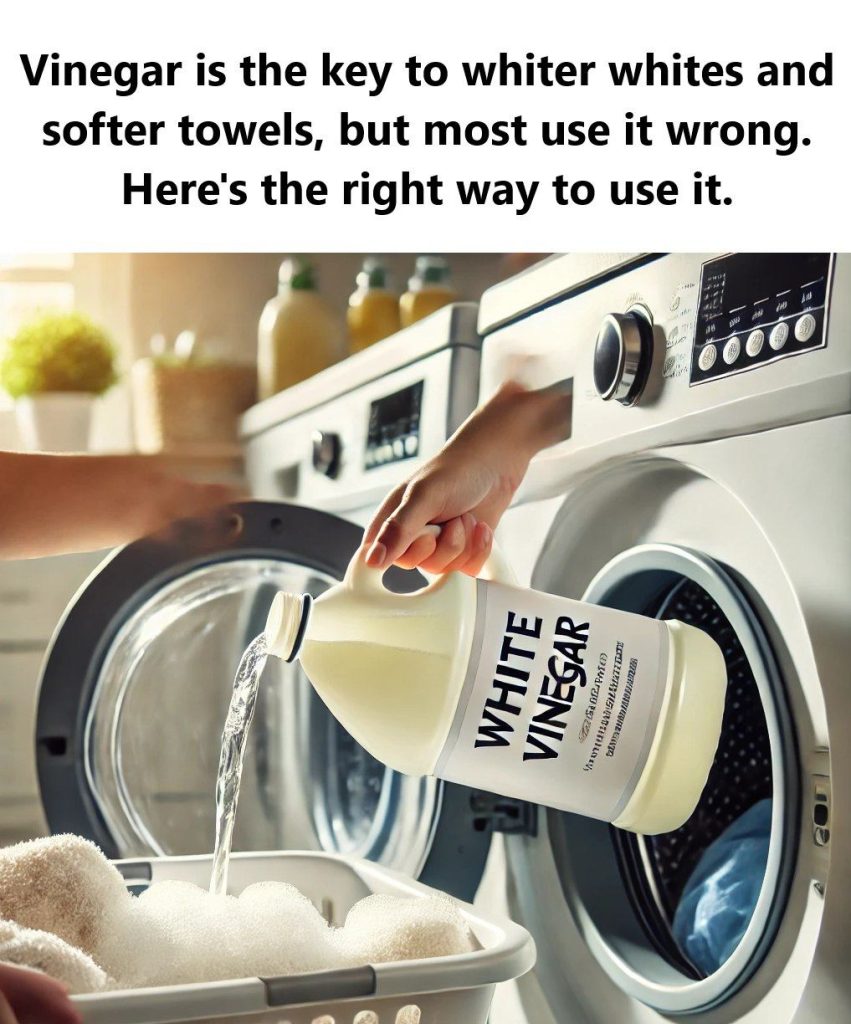If you’ve ever heard of using vinegar in your laundry routine, you’re probably aware of its reputation as a miracle worker. From softening towels to whitening clothes, vinegar is touted as an all-natural, budget-friendly alternative to chemical-laden laundry products. However, while many people attempt to use vinegar for these purposes, they often don’t see the results they expect because they’re using it the wrong way.
In this article, we’ll dive into how vinegar works, common mistakes, and the correct method to maximize its potential for whiter whites and softer towels.
Why Vinegar Works Wonders in Laundry
Vinegar, specifically white distilled vinegar, is a powerful cleaning agent due to its high acidity level (about 5%). This acidic property is what makes it effective at breaking down soap residues, neutralizing odors, dissolving mineral buildup, and brightening fabrics. When used correctly, it can be a game-changer for your laundry routine.
Here’s how vinegar benefits your laundry:
- Softens Towels: Over time, towels accumulate detergent and fabric softener residues that cause them to become stiff and less absorbent. Vinegar helps strip away these residues, leaving towels softer and fluffier.
- Whitens Whites: Detergent and hard water minerals can build up on white fabrics, causing them to dull and yellow over time. Vinegar helps to dissolve these buildups, restoring the brightness of your whites.
- Neutralizes Odors: Vinegar’s natural acidity neutralizes odors, making it ideal for musty towels, sweaty gym clothes, and anything with lingering smells.
- Reduces Lint and Static Cling: Vinegar can also help reduce static cling and lint buildup, meaning less hassle with fuzz-covered clothes after drying.
Common Mistakes People Make with Vinegar in Laundry
While vinegar is a natural powerhouse, it’s easy to misuse. Here are some common mistakes people make:
- Using the Wrong Type of Vinegar: The key to successful laundry care is using white distilled vinegar, not apple cider vinegar or other vinegar varieties. Colored vinegars like balsamic or red wine vinegar can stain fabrics.
- Adding Vinegar Directly to Detergent: Some people pour vinegar directly into the detergent compartment or mix it with their laundry detergent, which can counteract the cleaning power of the detergent. Vinegar should not be combined with most laundry detergents, as the acidic vinegar can neutralize the detergent’s effectiveness.
- Using Too Much Vinegar: Thinking more vinegar equals better results can backfire. Using too much can make your clothes smell like vinegar or even cause damage to certain fabrics over time.

The Right Way to Use Vinegar for Whiter Whites and Softer TowelsTo truly harness the benefits of vinegar, it’s important to use it properly. Follow these simple steps to get the most out of this natural laundry booster:
1. For Softer Towels
- Step 1: Wash your towels with your regular detergent, but skip the fabric softener. Fabric softeners coat towel fibers, making them less absorbent.
- Step 2: During the rinse cycle, add ½ to 1 cup of white distilled vinegar directly into the fabric softener compartment or pour it directly into the drum. This ensures that the vinegar does its work in the final rinse, where it will strip away residue and soften the fabric.
- Bonus Tip: For extra softness, you can occasionally run a load of towels with only vinegar (no detergent). This helps eliminate deep-seated detergent buildup.
2. For Whiter Whites
- Step 1: Start by sorting your whites from colored fabrics to avoid color bleeding.
- Step 2: Add your regular detergent to the wash cycle as usual.
- Step 3: In the rinse cycle, pour 1 cup of white distilled vinegar into the fabric softener compartment or directly into the drum. Vinegar will help lift any detergent residues and mineral buildup that dull whites.
- Bonus Tip: For an extra whitening boost, soak white clothes in a mixture of hot water and 2 cups of vinegar for 30 minutes before washing. This pre-treatment helps dissolve stubborn yellowing or dinginess.
3. To Neutralize Odors
- Step 1: If you’re dealing with particularly smelly laundry (like gym clothes or musty towels), add 1 cup of vinegarto the rinse cycle. For heavily soiled items, you can add 1 cup of vinegar to a pre-soak cycle.
- Step 2: Let the vinegar work its magic by breaking down bacteria and deodorizing the fabric.
4. To Reduce Lint and Static
- Step 1: Add ½ cup of white distilled vinegar to your rinse cycle to help reduce lint and static cling.
- Step 2: Alternatively, you can dampen a clean cloth with vinegar and toss it in the dryer with your clothes to further prevent static.
Tips for Best Results
- Don’t worry about the vinegar smell: The smell of vinegar dissipates once your clothes are dry, so you won’t be left with any lingering scent.
- Don’t overdo it: While vinegar is a fantastic laundry booster, using it too frequently or in excessive amounts can wear down the elasticity of certain fabrics. Use it sparingly for delicate fabrics like spandex or silk.
- Avoid mixing with bleach: Never mix vinegar and bleach in your laundry. The combination creates chlorine gas, which can be harmful when inhaled.
Conclusion
White distilled vinegar is the unsung hero of laundry care. When used correctly, it can make a noticeable difference in the softness of your towels and the brightness of your whites. The key is to introduce vinegar at the right stage in your wash routine—during the rinse cycle—and in the proper amounts. By avoiding common mistakes and following these simple steps, you’ll enjoy softer, fresher, and brighter laundry without the need for expensive fabric softeners or harsh chemicals.



